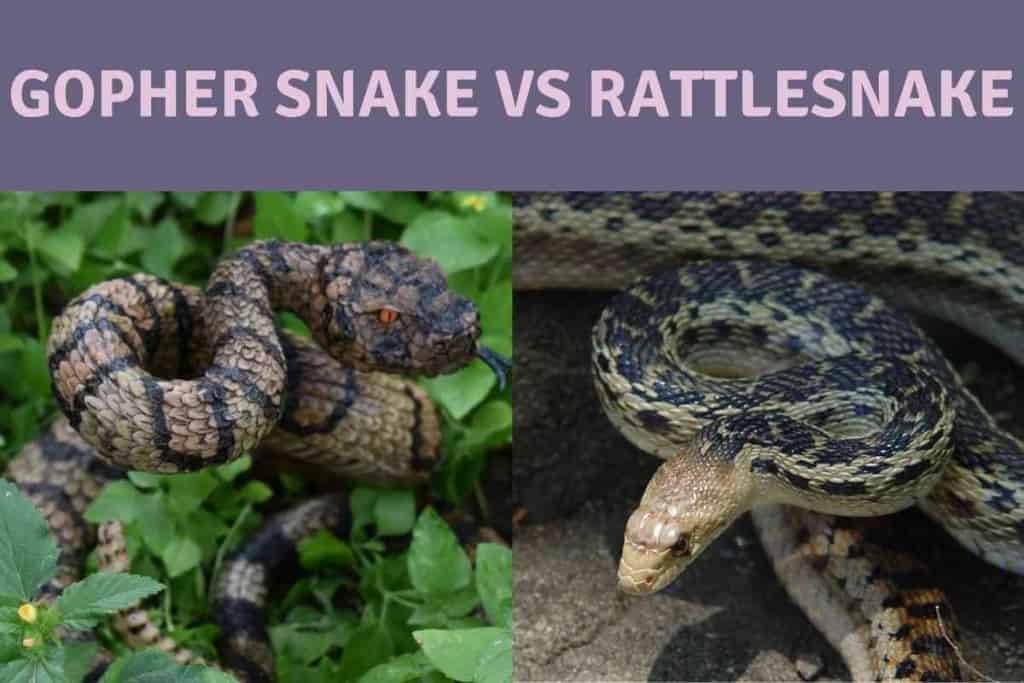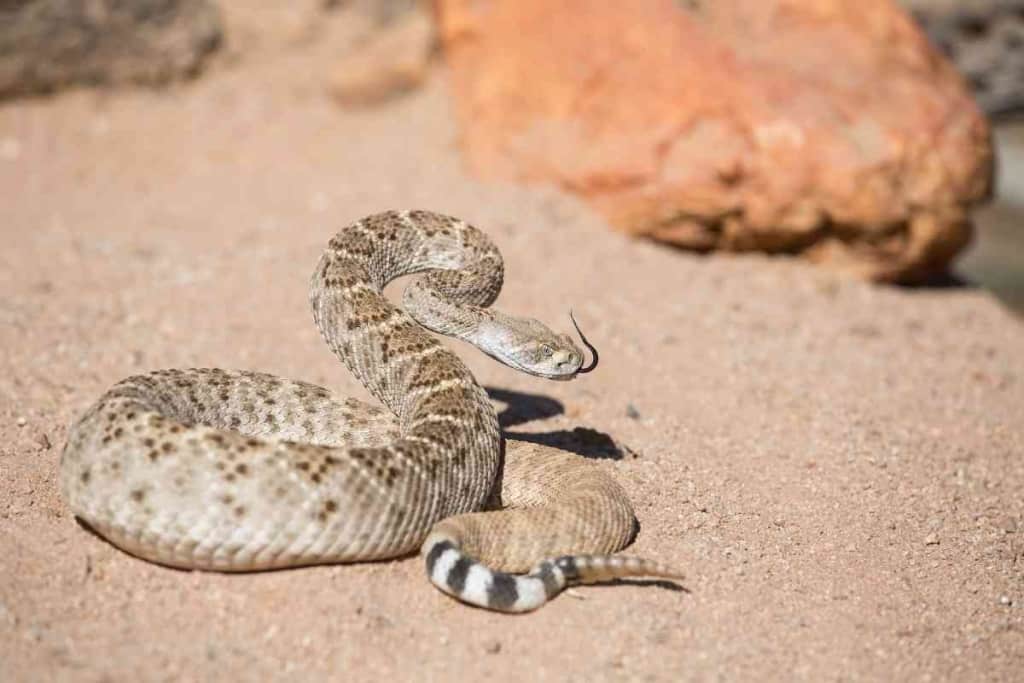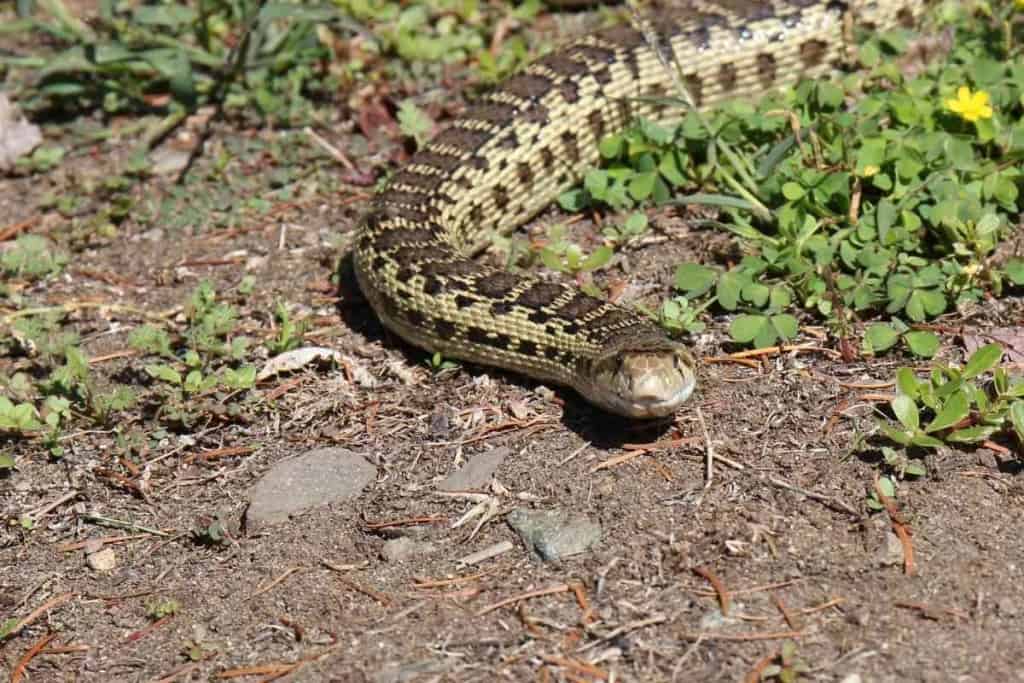Gopher Snake Vs Rattlesnake: 15 Key Differences Explained
A Gopher snake mimics a rattling sound made by a rattlesnake, so how can you tell them apart? Because of its markings and protective behavior, the gopher snake is sometimes mistaken for a rattlesnake. Both look alike and are short-tempered, but only one delivers a nasty bite.

What’s the difference between a Gopher snake and a Rattlesnake?
Gopher snakes lack a rattle, are longer and more slender than rattlesnakes, have narrow heads, round pupils, no pits, and are non-venomous. On the other hand, rattlesnakes have a rattle, spade-shaped heads, slit-like pupils, heat-sensing “pits” near their nostrils, and are venomous.
If you’ve ever found yourself debating whether you’re looking at a neighborhood-friendly gopher or a potentially lethal rattlesnake, you know how crucial it is to distinguish between them. The harmless gopher snake is often killed due to this confusion.
So, how do you tell if you’re looking at a harmful gopher or a potentially lethal rattlesnake? It turns out there are some pretty easy hacks to tell them apart. After extensive research, here are gopher snake vs rattlesnake 15 Key Differences Answered!
Is it a Gopher Snake or a Rattlesnake: 15 Key Differences!
| Gopher Snake | Rattlesnake | |
| Scientific name | Pituophis catenifer | Vipers of the Crotalus family |
| Origin | North America | Southwest US, Argentina, Mexico |
| Longevity | 10 to 25 years | 10 to 20 years |
| Size | 6 to 9 ft.Body is relatively narrower. | 3 to 6 ft.Heavy-set body that appears almost ‘fat’. |
| Color and Pattern | Uneven blotches of orange, brown, and yellow | A diamond pattern in shades of brown |
| Venom | Non-venomous – lack fangs | Venomous – has fangs. |
| Killing Method | Constriction | Venomous bite |
| Special Features | Lacks a rattle but is a great mimic. | Has a rattle and pits for sensing. |
You should not take any chances when distinguishing between gopher snake and rattlesnake. Check out these 15 key differences answered.
Difference #1: The Rattle
The rattle located on the end of a rattlesnake’s body is absent in gopher snakes. On the other hand, adult rattlesnakes generally have a good-sized rattle near the blunt end of their tail.
While rattlesnakes are the true rattlers, a gopher snake mimics the rattling to scare off threats. This is accomplished by shaking its rear in the manner of a rattler. The sound is produced when the tail rubs against the ground or dry vegetation.
However, some rattlesnakes lose their rattles due to various environmental factors. Thus, don’t assume that you’re looking at a gopher snake because there is no rattle.
To confirm, check the apex of the tail. In gopher snakes, the tail tapers to a thin, pointed end, while in rattlesnakes, the scales modify into a cluster ending in a blunt, rounded shape.

Difference #2: Overall Size
When an adult rattlesnake is placed next to a fully grown gopher snake, the latter wins the size contest. The average adult gopher snake size is 6 to 9 feet long; most reach 8 feet. Rattlesnakes range from 3 to 6 feet, depending on the species.
However, while being almost twice the length of rattlers, gopher snakes have a significantly narrower girth. Rattlesnakes are heavy-bodied, while gopher snakes are whip-like.
Difference #3: Head
The size of the head is another differentiating feature between the two snake species. A rattlesnake’s head is shaped more like an arrow or triangular shape, like a pit viper. This makes the head notably more prominent than its slender neck.
Herpetologists ascribe the difference in head size to the huge venom glands at the rear of their heads. Because gopher snakes are constrictors, they lack venom glands, resulting in heads as slender as their necks.
Difference #4: Shape of the Pupils
The pupils of a rattlesnake are vertical, as they are in all viper species. On the flip side, the pupils of a gopher snake are spherical.
But to tell the difference, you’d have to get too close for your liking. This could be achievable if the serpent is kept in a cage. But if you’ve just discovered it in your yard, you can see why this would be an issue.
Difference #5: Venom
One of the primary distinctions between a gopher snake vs rattlesnake is their venom. Gophers are non-venomous, and while they may bite you (usually in defense), it is completely harmless.
Crossing to the other side, rattlesnakes have venom that’s produced in glands located in the snake’s upper jaw. Their venom is a complex mixture of chemicals, yet a bite is rarely lethal.
Aside from the horrific bleeding from the bite site, the victim’s blood pressure plummets dramatically. And if left untreated, it can kill a fully-grown adult. As a result, a rattlesnake bite is considered a medical emergency.
Difference #6: How they kill
Gopher snakes and rattlesnakes frequently compete for territory and food. Their primary food sources include rabbits, squirrels, ground-nesting birds, mice, and other rodents. The key difference is in the hunting and feeding method.
Rattlesnakes ambush their victim. They wait for the right moment and attack. They kill the prey with a lethal bite before devouring it whole. Gopher snakes hunt with their excellent sense of smell. When they strike, they coil around the animal, effectively constricting it to death.
Rattlesnakes have two enormous fangs on their upper jaw to inject venom. Gopher snakes lack fangs because they are constrictors. Instead, they have numerous tiny, hooked teeth for gripping their prey while they squeeze it.
Difference #7: Dorsal Pattern
To people unfamiliar with common snake breeds, a gopher snake vs rattlesnake might look alike. But if you were to look close enough, you would notice a difference in the color and pattern of the bodies of the snakes.
Color is quite a variable in gopher snakes vs rattlesnakes, but there is a notable difference in the dorsal design. The Gopher has a dark checkered pattern that looks like a chain of squares or rectangles. But most rattlesnake species have a distinct diamond dorsal pattern.
Difference #8: Location
The range of the gopher snake is extensive. They inhabit coniferous forests, brushlands, woodlands, prairies, deserts, and cultivated fields. Geographically, this means they can be found in most states. They are one of the most widespread species in the US.
According to the University of Michigan’s Animal Diversity Web (ADW), you can spot gopher snakes from north of Mexico to Western and South Central Canada. They can be found west to the Pacific coast, West Texas, Missouri, Illinois, north through Wisconsin, Saskatchewan to southern British Columbia.
Rattlesnakes occupy deserts, marshes, plains, woodlands, and foothills. They are abundant in the deserts of the southwestern United States but range from southern Canada to central Argentina.

Difference #9: Breeding and Reproduction
When it comes to the reproductive behavior of these snakes, one is oviparous (lays eggs) while the latter is ovoviviparous (gives birth).
Gopher snakes mate during spring, right after hibernation. After about 8 weeks, pregnant females lay eggs that hatch after another 8 weeks. Rattlesnakes are one of the few snakes that give birth to live young.
Although they don’t hibernate through winter, rattlesnakes also breed in spring. This species lays eggs but keeps them incubated for about 7 months until they hatch and come out as snakelets.
Difference #10: Defensive Behavior
Now here is where all the intrigue lies. Indeed if a snake shakes its tail, it’s got to be a rattlesnake. Not necessarily. The gopher snake has mastered the art of mimicry.
Gophers morph their heads to resemble that of a rattlesnake. They have loosely connected jawbones that enable them to flatten out their heads into a triangular shape. They will also hiss and vibrate the tail when agitated, just like an original rattler.
Difference #11: Color
These two species of snakes can be distinguished by their appearance, including their coloration.
Gopher snakes are typically brown or tan in color, with dark blotches down their back. They can grow to be quite large, up to six feet in length. Rattlesnakes, on the other hand, are usually darker in color, with a pattern of diamonds or squares along their back. They also have a rattle at the end of their tail, which is used to warn predators of their presence.
Difference #12: Diet
One common difference between the diet of a gopher snake and a rattlesnake is the type of prey each snake typically eats. Gopher snakes are known to eat mostly small mammals, such as rodents and rabbits. On the other hand, rattlesnakes tend to prefer birds and lizards as their main source of food.
This difference in diet can be attributed to the different habitats each snake species inhabits. Gopher snakes are typically found in open grasslands and prairies, while rattlesnakes are more commonly found in rocky desert regions.
Therefore, the type of prey available to each snake is different based on its habitat. Another difference between the diet of these two snakes is the way they hunt for their food. Gopher snakes are known to be constrictors, meaning they kill their prey by wrapping their body around it and squeezing it until it suffocates.
On the other hand, rattlesnakes are venomous, meaning they kill their prey by injecting them with a deadly toxin through their fangs. This difference in hunting methods is also likely due to the different habitats these snakes live in. constrictor snakes are typically found in areas with lots of vegetation, where they can use their long bodies to coil around their prey and squeeze it to death.
Venomous snakes, on the other hand, are typically found in open desert regions where there is not much vegetation for them to hide. Therefore, they have adapted to hunting by injecting their prey with venom, which quickly kills it.
Difference #13: Snout
One of the easiest ways to tell a gopher snake apart from a rattlesnake is by looking at the snout. Gopher snakes have a much rounder, blunter snout than rattlesnakes.
Rattlesnakes, on the other hand, have a much more pointed and triangular-shaped snout. This difference is most noticeable when the snakes are viewed from above. Another way to tell these two types of snakes apart is by looking at their eyes. Rattlesnakes have elliptical pupils, while gopher snakes have round pupils.
Finally, gopher snakes tend to be overall larger in size than rattlesnakes. So if you’re ever unsure which type of snake you’re looking at, take a close look at the snout and eyes. Chances are, if it’s a gopher snake, you’ll be able to tell right away.
Difference #14: General Behavior
Gopher snakes and rattlesnakes behave very differently, even though they are both reptiles. Gopher snakes are shy and will usually try to flee when they feel threatened. On the other hand, rattlesnakes are aggressive and will often attack when they feel threatened. This difference in behavior is likely due to the different environments that these two types of snakes live in.
Gopher snakes typically live in burrows underground, while rattlesnakes live in more open areas such as deserts. This difference in habitat may cause the different behaviors that we see in these two types of snakes.
Difference #15: Care
- Choose the right type of cage. A rattlesnake needs a sturdy, escape-proof cage that is large enough for it to move around comfortably. The cage should also have a secure lid to prevent the snake from getting out.
- Provide plenty of hiding places. Rattlesnakes like to have somewhere to hide, so make sure there are plenty of hiding places in the cage. This can be achieved by using rocks, logs, or other objects that the snake can slither under or into.
- Keep the cage clean. Like all animals, rattlesnakes need a clean environment to stay healthy. Be sure to clean the cage regularly and remove any waste immediately.
- Don’t handle your snake too much. Although it is okay to handle your rattlesnake occasionally, it is important not to do so too often. This can stress the snake out and make it more likely to bite.
- Be careful when feeding. When feeding your rattlesnake, be sure to use tongs or gloves to avoid being bitten. It is also important to only feed the snake live prey that is small enough for it to eat easily.
By following these tips, you can help ensure that your pet rattlesnake stays healthy and happy.
When it comes to gopher snakes, you need to provide them with large enclosures that have plenty of hiding places, branches, and rocks. Maintain a consistent temperature and humidity level in the enclosure. Feed your gopher snake live food such as mice or rats and handle it regularly to help it get used to humans. You should also make sure to take your gopher snake to the vet for regular checkups.
Gopher Snake Vs. Rattlesnake: Similarities
- Both gopher snakes and rattlesnakes are members of the subfamily Crotalinae, which contains all pit vipers.
- Pit vipers get their name from the heat-sensing pits located on each side of their head between the eye and nostril. These sensory organs allow them to “see” in infrared, allowing them to detect warm-blooded prey even in complete darkness.
- All pit vipers share a similar triangular-shaped head, which is wider than the neck.
- Gopher snakes and rattlesnakes both have long, hinged fangs that they use to inject venom into their prey.
- The venom of both gopher snakes and rattlesnakes is primarily composed of enzymes that begin to break down tissue and cause swelling, pain, and necrosis.
- Gopher snakes and rattlesnakes are both found in North and Central America.
- Both gopher snakes and rattlesnakes are ambush predators, meaning they wait for their prey to come to them rather than chasing it down.
- When they strike, pit vipers can extend up to two-thirds of their body length.
- Pit vipers use their venom primarily to kill and subdue prey, not for self-defense. However, if they feel threatened, they will not hesitate to bite.
- The majority of bites occur when humans inadvertently step on or otherwise disturb a snake that is resting in tall grass or underbrush.
- Both gopher snakes and rattlesnakes will give warning signs before biting, such as coiling their body and displaying their fangs. If these warnings are ignored, the snake will strike.
- Bites from either type of snake can be extremely painful and may result in serious injury or even death if not treated promptly.
Do Gopher Snakes Eat Rattlesnakes?
Yes, a Gopher snake can eat a rattlesnake. Gopher snakes excel in climbing, swimming, and burrowing. This allows for a more diverse diet.
The rattlesnake occasionally appears on the gopher’s menu in addition to insects, lizards, small animals, birds, and their eggs.
Because they compete for food and territory with rattlesnakes, you won’t typically find both in the same area. For this reason, gopher snakes will help keep rattlers away. But they will only go after a threatening rattler or if it is hungry.
The hunting method varies when the rattlesnake is the prey. The gopher snake lays in wait and strikes when ready. But instead of the usual constriction method, the Gopher grabs the rattlesnake by the head and suffocates it before swallowing it from head to tail.
What to Do When You See a Rattlesnake
If the serpent you’re looking at is a rattlesnake by some chance, you must exercise caution to avoid a trip to the ER. Here’s what to do when you see a rattlesnake.
- Don’t panic; don’t scream, and don’t run away – remain calm.
- Ensure there are at least 5 ft between you and the snake.
- Coiled, rattling, and head raised? If possible, step back to increase the striking distance. It’s best to stand at about 15 ft from the viper.
- Hold your ground and stand still for a few minutes. Rattlesnakes are not aggressive and will likely slither away once they establish you are not a threat.
- If a bite occurs, stay calm, call 911, and request medical assistance.
